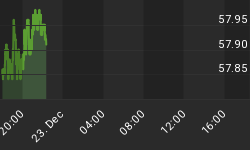Ready for inflation in finance, living costs and bone-headed stupidity...?
SINCE MONEY MAKES the world go round, more of it would set the earth spinning faster, right? Which would be a good thing, of course...
- "The case for targeting 4% to 6% inflation is certainly growing," says Australia's Financial Review, quoted by Kris Sayce at Money Morning down under;
- "I'm advocating 6% inflation for at least a couple of years," says former IMF economist and current Harvard don, Ken Rogoff;
- "It may be preferable to create limited inflation early on," agrees Spyros Andreopoulos, another economist, this time at Morgan Stanley;
- "A 2% steady-state inflation rate may be insufficiently high to stop [zero-interest rates] from having significant deleterious effects," says John Williams of the San Fran Fed.
With it so far? Oh do keep up. Inflation for these buffoons, as Kris notes in horror, means a rising cost of living.
Which would come about, no doubt, thanks to a surging supply of money and credit, otherwise known as inflation of the currency. Which can be sparked either by the printing press or, more typically since World War II, sub-zero rates of interest after you account for the rising cost of living.
You see, money that retains its value just won't do. "It's soft money makes the world go round," as a friend at the Economist magazine put it to me over a pint recently. How else do you think Western civilization refined itself to our current state of perfection?
Hard money on the other hand - the "sound money" beloved of pre-War bondholders awaiting repayment in gold - leaves too much freedom, too much discretion, to private individuals. Safe from an inevitable loss of value in cash, both savers and investors - as well as potential debtors - would be left to judge their decisions solely on the situation's own merits. And that just wouldn't do at all.
Got to keep things moving!

"The strong and prolonged deviation of money growth from its reference value since 2001 has caused concern among policymakers about the upside risks to price stability stemming from monetary developments," wrote three Banca d'Italia analysts in a research paper of May 2007.
In short, the Eurozone's money-growth target - the acceptable rate of money inflation (well, acceptable to central bankers at least) - had been informally set at 4.5% per year. Yet through the first decade of the single currency, however, annual money-supply growth doubled that rate and more.
Here in London, chief central-bank pooh-bah Mervyn King also started murmuring about the boom in credit and lending - then hitting a three-decade peak near 20% per year.
Surely consumer-price inflation would follow like ice cream follows pizza...?
"Those risks might be smaller than previously assumed," suggested Ferrero, Nobili and Passiglia. "Current excess liquidity conditions are related, to a considerable extent, to the acceleration of non-bank financial intermediaries' money demand, as well as to the accumulation of marketable instruments. Such increases are likely to be related more to portfolio choices than to transaction motives."
This was barely three months before the banking crisis began, you'll note, and the Trouble with Cheap Money was bound to show up eventually. Consumer-price inflation was about to surge as well, breaking to decade-highs across the West as crude oil leapt, dragging base metals and foodstuffs with it. But "portfolio choices", or so we guess here at BullionVault, were helping soak up the money inflation that would have otherwise shown up in "price stability" (or rather the lack thereof). This substitution brought its own crash-and-burn in the end, of course. But not before it lulled central bankers into thinking there was hardly any mischief afoot at all.
"Beginning in the 1980s, the cult of the markets - which included the development of financial derivatives and the increasing use of leverage - began to dominate," writes Bill Gross, the dominant 'bond king' at Pimco, the world's largest fixed-income manager.
"A long history marred only by negative givebacks during recessions...produced a persistent increase in asset prices vs. nominal GDP that led to an average overall 50-year appreciation advantage of 1.3% annually...[and so] the return from all assets was 100% higher than what it theoretically should have been from 1956.
"Financial leverage drove the prices of stocks, bonds, homes, and shopping malls to extraordinary valuation levels," says Gross. And we all know to our cost what happened next.
To repeat: The 1980s' deregulation and democratization of speculative risk meant money-supply growth didn't show up in consumer prices. Credit and debt meant the "feelgood factor" still applied, but unlike the wage-hikes of the '60s and '70s, the resulting inflation was frozen in bricks, mortar, brokerage accounts and pension funds. Nor did the big win go to the speculators either, not now the casino was so crowded, only the croupiers were sure to come out ahead. Which is just what they did.
Now the world's great brains want to see real interest rates sink further, back to sub-zero levels last seen during the late 1970s. Creating inflation in money is one thing, however; containing it in speculative card-shuffling quite another. The last three decades of financial rent-seeking are attempting to make a comeback this fall. But we wouldn't bet against inflation showing up in the cost of living as well if not instead.
















